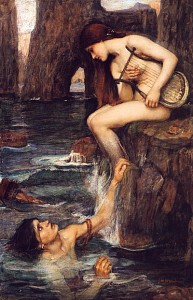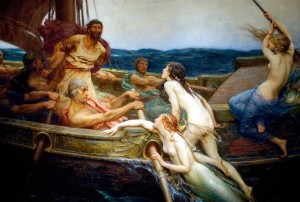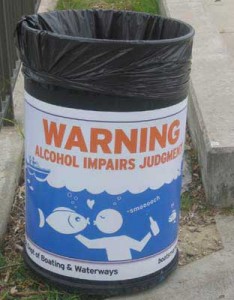It is not difficult to explain the myth of the mermaid. However, the representation of silky-blonde, scallop-bra-clad, marine glamour is some way from the reality of furtive couplings between desperate coast-dwellers and stranded fish. It is entirely understandable that the men concerned would wish to present their cross-species gamete transfer as something other than having sex with an enormous fish.
Homer’s Odyssey provides an ancient example of the legend. It is clear that Odysseus and his crewmen, deprived of female companionship for long periods but surrounded by the juice of the grape and apparently nubile creatures of the depths, succumbed to the obvious temptations. Their transgressions were later disguised by bards hired to put an acceptable spin on the debauched activities of a shipload of returning soldiers on an extended stag party. The Odyssey is the ultimate shaggy dog story, disguising a string of episodes of inebriated bestiality as a quest bravely undertaken by pure, god-fearing heroes.
The Sirens, Circe, the Lotus eaters, Nausicaa, Ino, Scylla and even Charybdis (witness the symbolism of the sucking whirlpool) are all, to some extent, mermaids, carefully crafted by Homer from the story’s core of unending sex with fish. The Sirens embody the essence of what became the mermaid: “overwhelming desire, linked to death, sexuality, suspended ego-consciousness and hallucination.” (Milne 2006, p67) Obviously, a man having sex with a fish is the epitome of suspended ego-consciousness – the forgetfulness of the self and the ability to disregard the judgements that would usually prevent a man from communing in certain ways with other beings. In what Nietzsche referred to as the Dionysian state of consciousness the “alienation of human beings from nature… is completely overcome.” (Schutte, 1986. p14) The final link in the conceptual chain is the hallucination, that remarkable ability of a man to take an image from his memory or imagination and allow it to substitute for grim reality.
The watery late Victorians such as Herbert James Draper and John William Waterhouse took advantage of the market for neo-classical pornography by producing some detailed pictures of highly sexualised sirens.
This effort by Waterhouse shows all of Milne’s characteristics of mermaids. A man risks death for sexual desire. The hallucination nears completion as the vestiges of the fish’s physical appearance disappear from the man’s consciousness. He is in that Dionysian state that will enable him to enjoy his fish in every way.
In Draper’s version, Odysseus’s suspended ego-consciousness is depicted in the contrast between his experience of the sirens and that of his unaroused crew. I particularly like the face of the rower at top centre as he watches his captain bellow out his lust for a carnivorous fish.
The great folklorist Vladimir Propp describes midsummer revels in Russia and Ukraine, drunken celebrations after which people costumed as water spirits take part in obscene talk and dancing, then at night time bathe in the river and engage in sexual activity that would be impossible outside the celebrations. (Propp 1987 p151) What do they do for the rest of the year? The midsummer spirit is limited to a single festive evening but alcoholic spirit is always available. Barber noted the appeal of the fish as a fertility symbol, its potency evident from the sheer number of eggs that it produces. Small wonder that the act of sex with such a bountiful female has not always attracted the opprobrium that it does now. Even today, California’s Department of Boating and Waterways considers it necessary to warn people that after imbibing sufficient alcohol, fish will inexplicably appear to be desirable sexual partners.
Considering the universal nature of human attraction to fish, it is hardly a surprise that the message from California has spread to all areas of the world.
In Waterhouse’s time, it was a small step from the idea of the ideal woman as pale, mysterious and distressed, probably consumptive, to the mermaid with her cold, white flesh, her enigmatic origins and her post-coital disappearance to the deep. One can readily visualise the Pre-Raphaelites, for example, in the midst of an absinthe and laudanum-fuelled orgy, suddenly achieving focus as the sun rises, realising the true meaning of aesthetic perfection and heading down to Billingsgate for the choicest sturgeon. In the post-stupor come-down, they would compound their debauchery with self-indulgence and cloak their clammy couplings in the imagery of perfection. What better symbol to do this than that of the mermaid?
References
Barber, E. J. W. (1997): On the Origins of the Vily/Rusalki. In Varia on the Indo-European Past: Papers in Memory of Marija Gimbutas, ed. M. Robbins Dexter and E. C. Poleme, pp 6-47. Washington D.C., Institute for the Study of Man.
Milne, Louise (2006): Mermaids and Dreams in Visual Culture. Cosmos, 22.. Pp 65-104
Propp, V. J. (1963) tr L. Gruel-Apert (1987): Les Faites Agraires Russes. Paris, Maisonneuve and Larose
Schutte, Ofelia (1986): Beyond Nihilism: Nietzsche Without Masks. University of Chicago Press.
Zuk, Rhoda (1997): The Little Mermaid: Three Political Fables. Children’s Literature Association Quarterly, Vol 22, No 4.

Categories: Uncategorized | No Comments »




